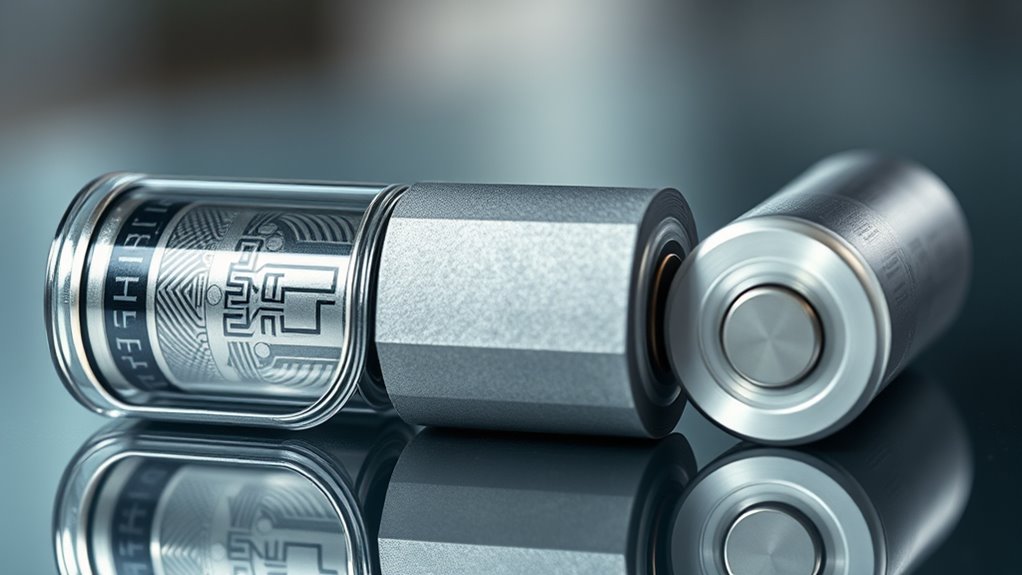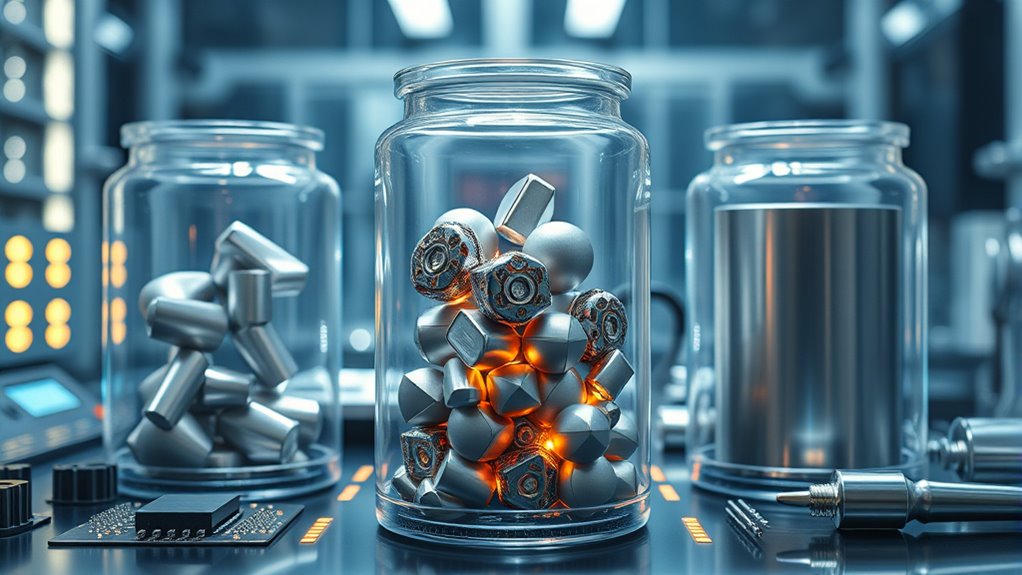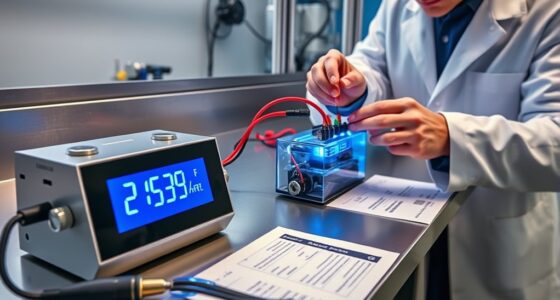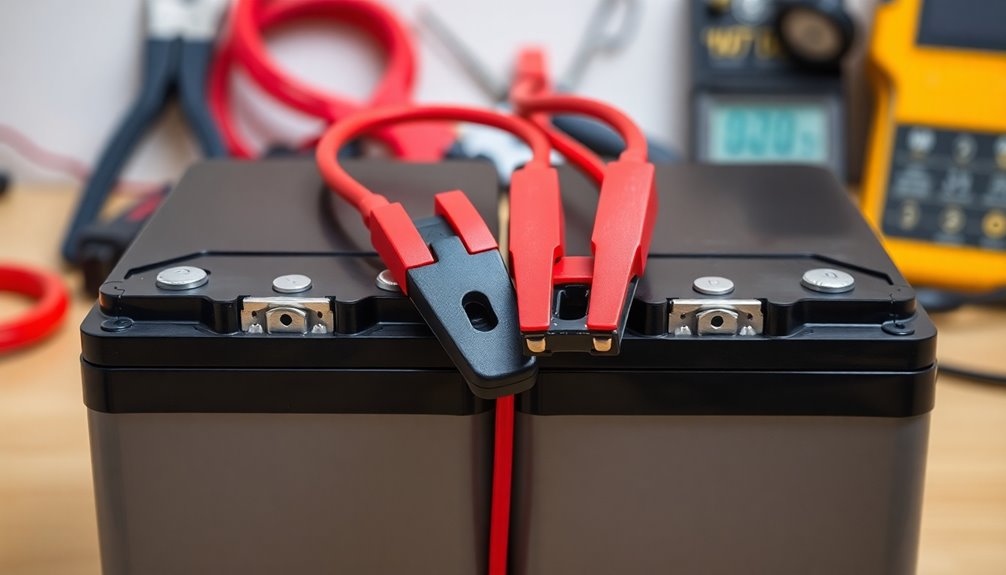Emerging battery chemistries like lithium-metal, magnesium, and aluminum are promising you higher energy densities, improved safety, and lower costs. Lithium-metal batteries offer greater capacity than traditional lithium-ion options and support faster charging, while magnesium and aluminum batteries provide lightweight, multivalent energy storage solutions ideal for various applications. These innovations aim to enhance performance and stability, paving the way for safer, more efficient batteries. Explore further to discover how these advancements could transform your energy storage choices.
Key Takeaways
- Lithium-metal batteries offer higher energy density with stable solid-state electrolytes to prevent dendrite growth.
- Magnesium batteries provide multivalent charge, increasing capacity and safety with solid electrolytes supporting multivalent ion transport.
- Aluminum batteries are lightweight and cost-effective, utilizing solid electrolytes for improved stability and cycle life.
- Advances in material science enhance electrolyte stability and interface compatibility for all three chemistries.
- Emerging chemistries aim to improve safety, energy density, and durability for applications like EVs and portable electronics.

As the demand for energy storage grows, researchers are exploring new battery chemistries that promise higher performance, longer life, and improved safety. Among these advancements, solid state electrolytes stand out as a game-changer. Unlike traditional liquid electrolytes, solid state electrolytes are non-flammable, more stable, and capable of withstanding higher voltages. This innovation not only enhances safety but also allows for the development of batteries with greater energy density. When combined with anode innovations, such as lithium-metal anodes, solid state electrolytes enable batteries to achieve unprecedented levels of efficiency and longevity. These anode improvements reduce the risk of dendrite formation, which is a common cause of short circuits and capacity loss in conventional lithium-ion batteries. As a result, you can expect batteries that charge faster, last longer, and operate more safely.
Research indicates that continuous monitoring of AI behavior and development of robust safety measures are crucial to mitigate vulnerabilities and biases in AI systems. Similarly, in battery technology, ongoing testing and safety protocols are essential to ensure reliability and security.
Lithium-metal batteries are at the forefront of this evolution. They employ a lithium-metal anode, which offers a much higher theoretical capacity compared to traditional graphite anodes. This means you get more energy stored in a smaller, lighter package, ideal for applications like electric vehicles and portable electronics. However, lithium-metal anodes are notoriously prone to dendrite growth, which can cause short circuits. Here, the integration of solid state electrolytes becomes *indispensable*. They provide a stable interface that suppresses dendrite formation, making lithium-metal batteries more reliable and safer for everyday use. Researchers are actively working on optimizing these materials, focusing on enhancing ionic conductivity and mechanical stability to support faster charging and improved cycle life.
In this context, advances in AI safety measures and materials science are both vital for ensuring the development of secure and efficient technologies.
Similarly, magnesium and aluminum batteries are gaining attention for their potential to deliver high energy density with increased safety. Magnesium, with its multivalent nature, can carry more charge per ion than lithium, promising batteries with higher capacities. Aluminum, being abundant and lightweight, offers the possibility of cost-effective energy storage solutions. In these emerging chemistries, solid state electrolytes play a *vital* role, providing the necessary stability to handle multivalent ions and enabling the development of more durable anodes. Innovations in anode materials for magnesium and aluminum batteries aim to improve their electrochemical stability and cycle life, making them viable alternatives to lithium-based systems.
Frequently Asked Questions
What Are the Environmental Impacts of New Battery Chemistries?
You might notice that new battery chemistries can reduce some environmental issues, but they also pose recycling challenges due to complex materials. Resource extraction impacts remain significant, as mining for elements like magnesium or aluminum can harm ecosystems and deplete resources. While these batteries could be more eco-friendly overall, it’s essential to develop better recycling methods and minimize extraction effects to truly benefit the environment.
How Do Costs Compare Among Lithium-Metal, Magnesium, and Aluminum Batteries?
You’ll find that lithium-metal batteries generally have higher manufacturing costs compared to magnesium and aluminum batteries, mainly due to more complex production processes and material costs. Magnesium batteries tend to be more affordable, offering a better cost comparison for large-scale use. Aluminum batteries are often the cheapest to produce because of abundant raw materials and simpler manufacturing. Overall, the cost comparison depends on materials, manufacturing complexity, and scale of production.
What Safety Concerns Are Associated With Emerging Battery Types?
You should know that emerging battery types pose notable safety concerns, with fire hazards being prominent. For instance, lithium-metal batteries are especially vulnerable to thermal runaway, which can cause fires or explosions. Magnesium and aluminum batteries may also face similar risks, though they’re generally considered safer. It’s essential to develop robust safety measures, as managing these hazards ensures safer use and prevents catastrophic failures like fires caused by thermal runaway.
Are These Batteries Suitable for Large-Scale Energy Storage?
These batteries face scalability issues, making them less suitable for large-scale energy storage currently. You’d need significant infrastructure upgrades to handle their unique requirements, such as advanced manufacturing processes and specialized safety measures. While promising, their development isn’t mature enough yet for widespread deployment. For now, traditional lithium-ion systems remain more practical for large-scale applications, but ongoing research may improve their scalability and infrastructure compatibility in the future.
What Are the Manufacturing Challenges for These New Chemistries?
You’ll face manufacturing challenges like scaling production and sourcing materials for these new chemistries. Lithium-metal, magnesium, and aluminum batteries require specialized processes to guarantee safety and performance, which aren’t yet fully developed. Securing high-quality, sustainable materials can be tough, and establishing efficient, cost-effective manufacturing methods takes time. Overcoming these hurdles is essential to bring these innovative batteries to large-scale energy storage and consumer markets.
Conclusion
As you explore these emerging battery chemistries, envision a future where lithium-metal, magnesium, and aluminum batteries light up your devices with brighter, longer-lasting power. Picture these metals as the sparks igniting a new era of energy, flowing like a vibrant river of innovation. With each breakthrough, you’ll see a world where your gadgets hum with unstoppable vigor, fueling dreams and progress. The horizon shines brighter—powered by these promising, transformative chemistries.










